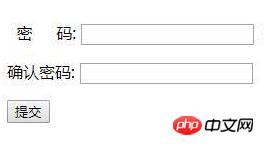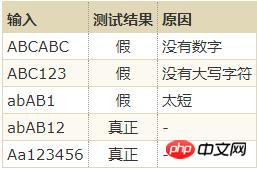 Web Front-end
Web Front-end
 JS Tutorial
JS Tutorial
 How does javascript use regular expressions to validate a form? (code example)
How does javascript use regular expressions to validate a form? (code example)
How does javascript use regular expressions to validate a form? (code example)
What this article brings to you is to introduce how JavaScript uses regular expressions to validate forms (code examples). It has certain reference value. Friends in need can refer to it. I hope it will be helpful to you.
In the previous article [How to perform simple password verification on the form in js? 】In this article, we introduce a more comprehensive method of validating forms through examples. It will check everything we want to check, but it uses a lot of code to test each requirement individually and display different error messages.
How to achieve the effect with a small amount of code? I believe many people will have such questions. In fact, it is also simple. You can solve this problem by using regular expressions.
Let's take a look at the method of javascript regular expression verification of the form through the password verification of the form.
HTML code:
<form method="POST" action="" onsubmit="return checkForm(this);"> <p>密 码: <input type="password" name="pwd1"><span> </p> <p>确认密码: <input type="password" name="pwd2"></p> <p><input type="submit"></p> </form>

The checkForm() function of js verifies the password and calls the regular expression:
function checkForm(form)
{
if(form.pwd1.value != "" && form.pwd1.value == form.pwd2.value) {
if(!checkPassword(form.pwd1.value)) {
alert("您输入的密码无效!");
form.pwd1.focus();
return false;
}
} else {
alert("错误:请检查您输入并确认您的密码!");
form.pwd1.focus();
return false;
}
return true;
}js regular expression:
function checkPassword(str)
{
var re = /(?=.*\d)(?=.*[a-z])(?=.*[A-Z]).{6,}/;
return re.test(str);
}Effect, enter password (123456):

The expression type used here is called "look -ahead", which attempts to match the included regular expression against the "future" part of the string.
Translate (the function implemented by the above regular expression):
1. Match a string of six or more characters;
2. Contain at least one number ( \d is the abbreviation of [0-9]);
3. At least one lowercase character
4. At least one uppercase character
Test it:

If you want to limit your password to only letters and numbers (no spaces or other characters), you only need to change it slightly. We use the wildcard \w, and we can complete:
Improved regular expression:
function checkPassword(str)
{
var re = /^(?=.*\d)(?=.*[a-z])(?=.*[A-Z])\w{6,}$/;
return re.test(str);
}The \W is the abbreviation of "any letter, number or underscore".
It's actually not a good practice to limit which characters are used, since punctuation and other symbols provide extra security.
Example of regular expression validation form:
html code:
<form method="POST" action="" onsubmit="return checkForm(this);"> <p> 用 户 名: <input type="text" name="username"><span> (输入必须只包含字母、数字和下划线)</span></p> <p> 密 码: <input type="password" name="pwd1"><span> (输入必须包含至少一个数字/小写/大写字母,并且长度至少为六个字符)</span></p> <p>确认密码: <input type="password" name="pwd2"></p> <p><input type="submit"></p> </form>
js code:
function checkPassword(str)
{
var re = /(?=.*\d)(?=.*[a-z])(?=.*[A-Z]).{6,}/;
return re.test(str);
}
function checkForm(form)
{
if(form.username.value == "") {
alert("Error: Username cannot be blank!");
form.username.focus();
return false;
}
re = /^\w+$/;
if(!re.test(form.username.value)) {
alert("错误:用户名必须只包含字母、数字和下划线!");
form.username.focus();
return false;
}
if(form.pwd1.value != "" && form.pwd1.value == form.pwd2.value) {
if(!checkPassword(form.pwd1.value)) {
alert("您输入的密码无效!");
form.pwd1.focus();
return false;
}
} else {
alert("错误:请检查您输入并确认您的密码!");
form.pwd1.focus();
return false;
}
return true;
}You’re done!
Rendering:
Summary: As you can see, regular expressions are very worth learning. They can be used not only in JavaScript, but also in PHP, Perl, Java and many other languages. Some text editors (not just vi) also allow them when searching or replacing text.
The above is the detailed content of How does javascript use regular expressions to validate a form? (code example). For more information, please follow other related articles on the PHP Chinese website!

Hot AI Tools

Undresser.AI Undress
AI-powered app for creating realistic nude photos

AI Clothes Remover
Online AI tool for removing clothes from photos.

Undress AI Tool
Undress images for free

Clothoff.io
AI clothes remover

Video Face Swap
Swap faces in any video effortlessly with our completely free AI face swap tool!

Hot Article

Hot Tools

Notepad++7.3.1
Easy-to-use and free code editor

SublimeText3 Chinese version
Chinese version, very easy to use

Zend Studio 13.0.1
Powerful PHP integrated development environment

Dreamweaver CS6
Visual web development tools

SublimeText3 Mac version
God-level code editing software (SublimeText3)

Hot Topics
 1671
1671
 14
14
 1428
1428
 52
52
 1329
1329
 25
25
 1276
1276
 29
29
 1256
1256
 24
24
 PHP regular expression validation: number format detection
Mar 21, 2024 am 09:45 AM
PHP regular expression validation: number format detection
Mar 21, 2024 am 09:45 AM
PHP regular expression verification: Number format detection When writing PHP programs, it is often necessary to verify the data entered by the user. One of the common verifications is to check whether the data conforms to the specified number format. In PHP, you can use regular expressions to achieve this kind of validation. This article will introduce how to use PHP regular expressions to verify number formats and provide specific code examples. First, let’s look at common number format validation requirements: Integers: only contain numbers 0-9, can start with a plus or minus sign, and do not contain decimal points. floating point
 Master regular expressions and string processing in Go language
Nov 30, 2023 am 09:54 AM
Master regular expressions and string processing in Go language
Nov 30, 2023 am 09:54 AM
As a modern programming language, Go language provides powerful regular expressions and string processing functions, allowing developers to process string data more efficiently. It is very important for developers to master regular expressions and string processing in Go language. This article will introduce in detail the basic concepts and usage of regular expressions in Go language, and how to use Go language to process strings. 1. Regular expressions Regular expressions are a tool used to describe string patterns. They can easily implement operations such as string matching, search, and replacement.
 How to match timestamps using regular expressions in Go?
Jun 02, 2024 am 09:00 AM
How to match timestamps using regular expressions in Go?
Jun 02, 2024 am 09:00 AM
In Go, you can use regular expressions to match timestamps: compile a regular expression string, such as the one used to match ISO8601 timestamps: ^\d{4}-\d{2}-\d{2}T \d{2}:\d{2}:\d{2}(\.\d+)?(Z|[+-][0-9]{2}:[0-9]{2})$ . Use the regexp.MatchString function to check if a string matches a regular expression.
 How to validate email address in Golang using regular expression?
May 31, 2024 pm 01:04 PM
How to validate email address in Golang using regular expression?
May 31, 2024 pm 01:04 PM
To validate email addresses in Golang using regular expressions, follow these steps: Use regexp.MustCompile to create a regular expression pattern that matches valid email address formats. Use the MatchString function to check whether a string matches a pattern. This pattern covers most valid email address formats, including: Local usernames can contain letters, numbers, and special characters: !.#$%&'*+/=?^_{|}~-`Domain names must contain at least One letter, followed by letters, numbers, or hyphens. The top-level domain (TLD) cannot be longer than 63 characters.
 How to verify password using regular expression in Go?
Jun 02, 2024 pm 07:31 PM
How to verify password using regular expression in Go?
Jun 02, 2024 pm 07:31 PM
The method of using regular expressions to verify passwords in Go is as follows: Define a regular expression pattern that meets the minimum password requirements: at least 8 characters, including lowercase letters, uppercase letters, numbers, and special characters. Compile regular expression patterns using the MustCompile function from the regexp package. Use the MatchString method to test whether the input string matches a regular expression pattern.
 Chinese character filtering: PHP regular expression practice
Mar 24, 2024 pm 04:48 PM
Chinese character filtering: PHP regular expression practice
Mar 24, 2024 pm 04:48 PM
PHP is a widely used programming language, especially popular in the field of web development. In the process of web development, we often encounter the need to filter and verify text input by users, among which character filtering is a very important operation. This article will introduce how to use regular expressions in PHP to implement Chinese character filtering, and give specific code examples. First of all, we need to clarify that the Unicode range of Chinese characters is from u4e00 to u9fa5, that is, all Chinese characters are in this range.
 PHP regular expressions: exact matching and exclusion of fuzzy inclusions
Feb 28, 2024 pm 01:03 PM
PHP regular expressions: exact matching and exclusion of fuzzy inclusions
Feb 28, 2024 pm 01:03 PM
PHP Regular Expressions: Exact Matching and Exclusion Fuzzy inclusion regular expressions are a powerful text matching tool that can help programmers perform efficient search, replacement and filtering when processing text. In PHP, regular expressions are also widely used in string processing and data matching. This article will focus on how to perform exact matching and exclude fuzzy inclusion operations in PHP, and will illustrate it with specific code examples. Exact match Exact match means matching only strings that meet the exact condition, not any variations or extra words.
 PHP returns the string from the start position to the end position of a string in another string
Mar 21, 2024 am 10:31 AM
PHP returns the string from the start position to the end position of a string in another string
Mar 21, 2024 am 10:31 AM
This article will explain in detail how PHP returns the string from the start position to the end position of a string in another string. The editor thinks it is quite practical, so I share it with you as a reference. I hope you will finish reading this article. You can gain something from this article. Use the substr() function in PHP to extract substrings from a string. The substr() function can extract characters within a specified range from a string. The syntax is as follows: substr(string,start,length) where: string: the original string from which the substring is to be extracted. start: The index of the starting position of the substring (starting from 0). length (optional): The length of the substring. If not specified, then



)
